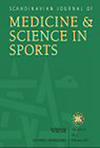血流限制与传统力量训练的动脉和静脉压力动态
IF 3.5
2区 医学
Q1 SPORT SCIENCES
引用次数: 0
摘要
力量训练反应受组数、重复次数和机械负荷的影响,而血流量限制(BFR)训练增加了通过止血带暂时限制血流量的变量。这加强了关于血管反应和BFR方法安全性的科学讨论。为了解决这些问题,我们研究了低负荷(LL‐RT)、低负荷伴BFR (LL‐BFR‐RT)和高负荷(HL‐RT)运动时血管内压力的变化。10名健康男性(26.8±4.59岁)在随机交叉设计中进行单侧肱二头肌卷曲至失败:(1)LL‐RT (30% 1RM), (2) LL‐BFR‐RT (30% 1RM, 50% LOP), (3) HL‐RT (75% 1RM)。与LL - BFR - RT(378±58.7 kg)和HL - RT(327±65.1 kg)相比,LL - RT组的总工作量(692±251 kg)显著更高,p <;0.001)。就平均值而言,与其他条件相比,LL - BFR - RT在两组之间的休息期间导致更高的舒张压和平均动脉压(p≤0.02)。与Hl‐RT相比,LL‐RT和LL‐BFR‐RT均导致舒张压升高(高于90 mmHg, LL‐RT: ~419 s vs. LL‐BFR‐RT: ~356 s vs. Hl‐RT: ~122 s)、收缩压(高于140 mmHg, LL‐RT: ~437 s vs. LL‐BFR‐RT: ~336 s vs. Hl‐RT: ~199 s)和平均动脉压(高于107 mmHg, LL‐RT: ~451 s vs. LL‐BFR‐RT: ~384 s vs. Hl‐RT: ~168 s)持续时间更长(p≤0.028)。相对于总运动时间,与Hl - RT相比,LL‐BFR‐RT导致舒张压升高(高于90 mmHg, LL‐RT: ~56.5% vs. LL‐BFR‐RT: ~68.7% vs. Hl‐RT: ~33.5%)和平均动脉压(高于107 mmHg, LL‐RT: ~60.8% vs. LL‐BFR‐RT: ~74.0% vs. Hl‐RT: ~45.7%)的时间比例更高(p≤0.034)。与其他情况相比,LL - BFR - RT组外周静脉压显著升高(p <;0.001),在高压下的绝对和相对时间(高于75 mmHg, LL‐RT: ~57.0 s和~ 9.12% vs. LL‐BFR‐RT: ~424 s和~ 81.7% vs. HL‐RT: ~36.0 s和~ 8.99%,p≤0.002)。我们的研究结果表明,与不进行BFR的高负荷训练相比,进行BFR训练至失败会对运动肢体施加更大的动脉和静脉压力,特别是由于长时间暴露于高压下。需要进一步的研究来评估频繁使用BFR导致局部动脉和静脉压力反应升高的潜在风险,特别是在已有疾病的人群中。本文章由计算机程序翻译,如有差异,请以英文原文为准。
Arterial and Venous Pressure Dynamics in Blood Flow Restriction Versus Traditional Strength Training
Strength training responses are influenced by sets, repetitions, and mechanical load, whereas Blood Flow Restriction (BFR) training adds the variable of temporarily restricting blood flow via a tourniquet. This has intensified scientific discussions regarding the vascular responses and thereby safety of the BFR method. To address these concerns, we investigated intravascular pressure changes during low‐load (LL‐RT), low‐load with BFR (LL‐BFR‐RT), and high‐load (HL‐RT) exercise. Ten healthy men (26.8 ± 4.59 years) performed unilateral biceps curls to failure in a randomized cross‐over design: (1) LL‐RT (30% 1RM), (2) LL‐BFR‐RT (30% 1RM, 50% LOP), and (3) HL‐RT (75% 1RM). Total workload was significantly higher in LL‐RT (692 ± 251 kg) compared to LL‐BFR‐RT (378 ± 58.7 kg) and HL‐RT (327 ± 65.1 kg, p < 0.001). In terms of mean values, LL‐BFR‐RT resulted in higher diastolic and mean arterial pressures during rest periods between sets compared to other conditions (p ≤ 0.02). Both LL‐RT and LL‐BFR‐RT led to longer durations spent at increased diastolic (above 90 mmHg, LL‐RT: ~419 s vs. LL‐BFR‐RT: ~356 s vs. Hl‐RT: ~122 s), systolic (above 140 mmHg, LL‐RT: ~437 s vs. LL‐BFR‐RT: ~336 s vs. HL‐RT: ~199 s), and mean arterial pressures (above 107 mmHg, LL‐RT: ~451 s vs. LL‐BFR‐RT: ~384 s vs. HL‐RT: ~168 s) compared to HL‐RT (p ≤ 0.028). Relative to total exercise time, LL‐BFR‐RT resulted in higher proportion of time spent at elevated diastolic (above 90 mmHg, LL‐RT: ~56.5% vs. LL‐BFR‐RT: ~68.7% vs. Hl‐RT: ~33.5%) and mean arterial pressures (above 107 mmHg, LL‐RT: ~60.8% vs. LL‐BFR‐RT: ~74.0% vs. HL‐RT: ~45.7%) compared to HL‐RT (p ≤ 0.034). Peripheral venous pressure was significantly higher in LL‐BFR‐RT compared to other conditions (p < 0.001), with both absolute and relative time spent at higher pressures (above 75 mmHg, LL‐RT: ~57.0 s and ~ 9.12% vs. LL‐BFR‐RT: ~424 s and ~ 81.7% vs. HL‐RT: ~36.0 s and ~ 8.99%, p ≤ 0.002). Our results suggest that BFR training performed to failure imposes greater arterial and venous stress in the exercising limb compared to high‐load training without BFR, particularly due to prolonged exposure to elevated pressures. Further research is needed to assess the potential risks of elevated local arterial and venous pressure responses by frequent BFR use, particularly in populations with pre‐existing medical conditions.
求助全文
通过发布文献求助,成功后即可免费获取论文全文。
去求助
来源期刊
CiteScore
7.90
自引率
4.90%
发文量
162
审稿时长
3 months
期刊介绍:
The Scandinavian Journal of Medicine & Science in Sports is a multidisciplinary journal published 12 times per year under the auspices of the Scandinavian Foundation of Medicine and Science in Sports.
It aims to publish high quality and impactful articles in the fields of orthopaedics, rehabilitation and sports medicine, exercise physiology and biochemistry, biomechanics and motor control, health and disease relating to sport, exercise and physical activity, as well as on the social and behavioural aspects of sport and exercise.

 求助内容:
求助内容: 应助结果提醒方式:
应助结果提醒方式:


